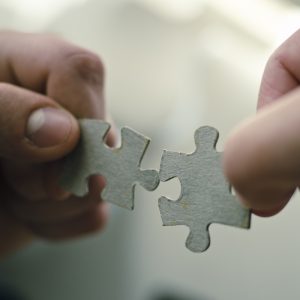 I am obsessed with jigsaw puzzles. Specifically, 1000-piece mystery puzzles, entertaining not just for their pictorial humor, but also for the challenge. Unlike traditional puzzles, you don't know what you are putting together because the completed puzzle isn't pictured on the box.
I am obsessed with jigsaw puzzles. Specifically, 1000-piece mystery puzzles, entertaining not just for their pictorial humor, but also for the challenge. Unlike traditional puzzles, you don't know what you are putting together because the completed puzzle isn't pictured on the box.
Mystery puzzles are constructed so that you must use your imagination about what will “happen next,” and what “happens next” becomes the final constructed puzzle image.
I know that puzzles are a great way to improve your short-term memory, but what I didn’t know was that that snapping a piece of a complex puzzle in place has actually been shown to release dopamine, that chemical messenger in our brain, which enhances our mood when we have a rewarding experience.
The fragmentation of my beloved puzzles makes me think about the fragmentation of healthcare – also beloved - but still being pieced together from a whole person perspective.
As I reflect on my clinical days, caring for those complex critical patients -- I see that I acted as that human interface, piecing together data from testing and response to treatment, to information gathered from family and if possible, the patients themselves. All of that data helped me to better understand and respond to their needs – generating a rewarding experience for both.
Today, I think about all of the technological capabilities at SAS, being able to create that 360-degree view of a patient, putting those pieces of the puzzle together in an automated way and using advanced analytics to uncover what might “happen next.”
It’s complicated, but possible to create a 360-degree view of a patient, as data from each interaction a patient has with their community of care, including details regarding their clinical care, behavioral health care and non-health systems care, including those received by social services, can be assimilated in to a single golden record.
This data, in concerto with other sources of data derived from socio-economic status (such as poverty and homelessness), allow us, as caregivers, to have a holistic understanding of a person’s needs and barriers to care that supports improving care delivery for an individual and population, as well as paint a picture that has impact at a system and policy level.
Like a puzzle piece clicked in to place to complete an image, assimilation of health and non-traditional (non-health) data sources, involves sophisticated entity resolution capabilities. By resolving entity and completing the whole person puzzle, we can go beyond the basics of risk stratification. We can use as many data points as possible to identify risk factors that might have not been identified by human analysis - uncovering what will likely “happen next,” and what the best possible intervention or treatment is.
Join my colleagues from SAS to understand how we can support you in completing the whole-person data puzzle - for patient impact, and for population health. Our recent on-demand webinar can be viewed here.
In addition, I'm headed to Dallas, April 28 - May 1, for the annual SAS Global Forum, which will feature dozens of sessions dedicated to making to most of your data with analytics for health care transformation. Hope to see you there!
Read more about emerging topics in health care
1 Comment
Love the way you've compared to a puzzle piece - that's what every living being is, a puzzle piece of nature and a puzzle themselves. Nice write up Heather.